MERCEDES-BENZ R-CLASS FAMILY TOURER 2013 Owners Manual
Manufacturer: MERCEDES-BENZ, Model Year: 2013, Model line: R-CLASS FAMILY TOURER, Model: MERCEDES-BENZ R-CLASS FAMILY TOURER 2013Pages: 364, PDF Size: 28.68 MB
Page 101 of 364
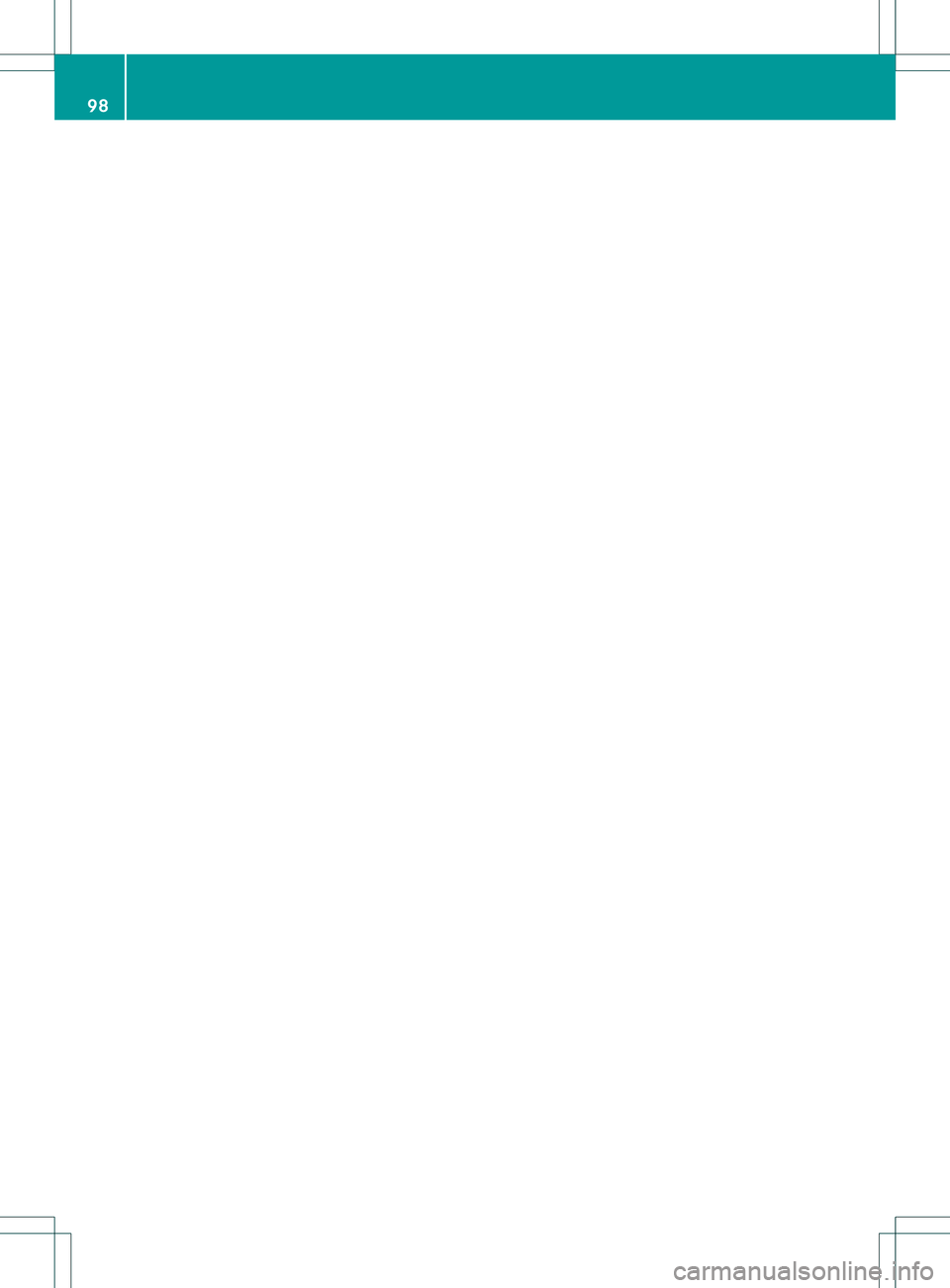
98
Page 102 of 364
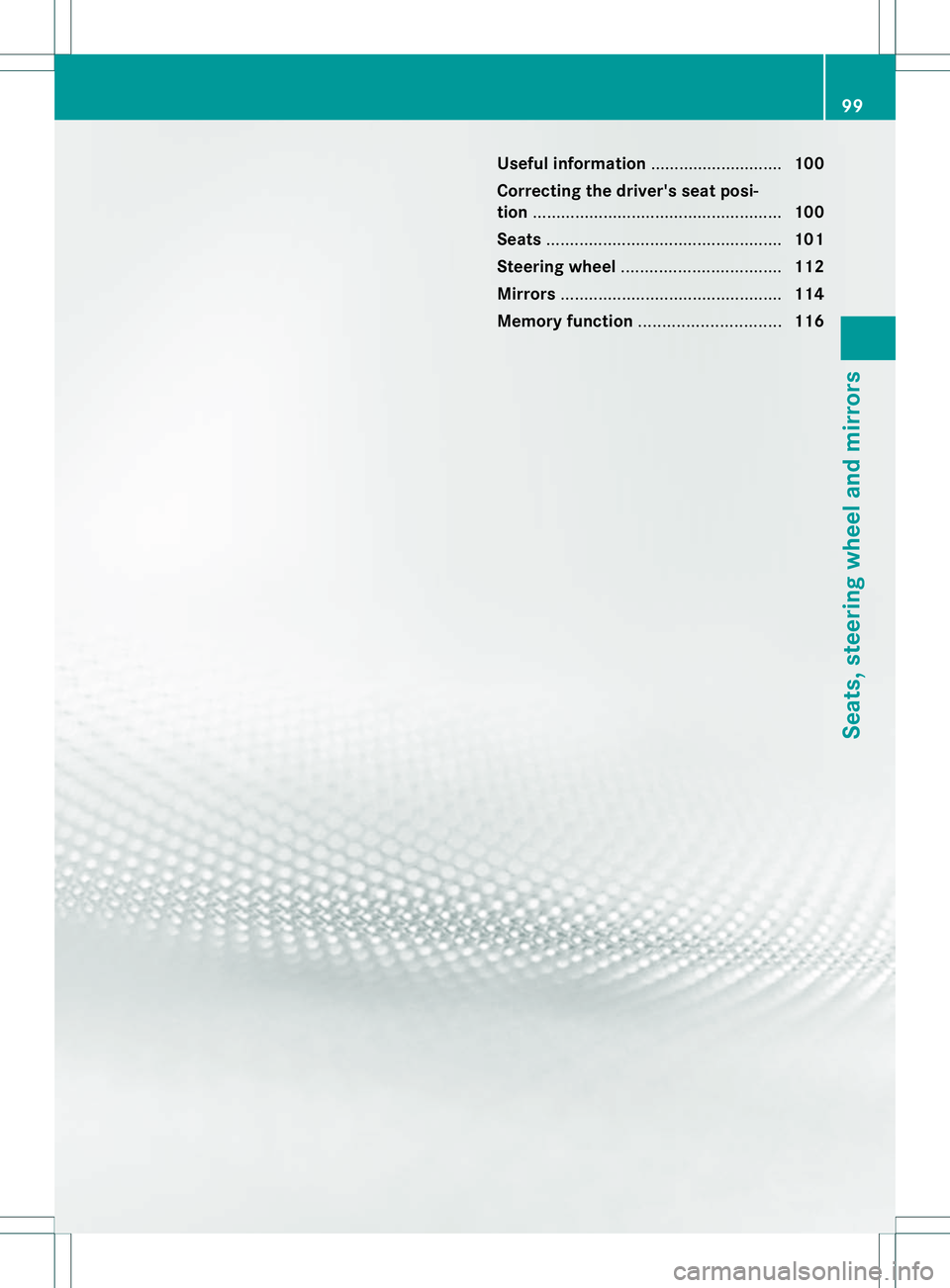
Useful information
............................100
Correcting the driver's seat posi-
tion ..................................................... 100
Seats .................................................. 101
Steering wheel .................................. 112
Mirrors ............................................... 114
Memory function .............................. 116 99Seats, steering wheel and mirrors
Page 103 of 364
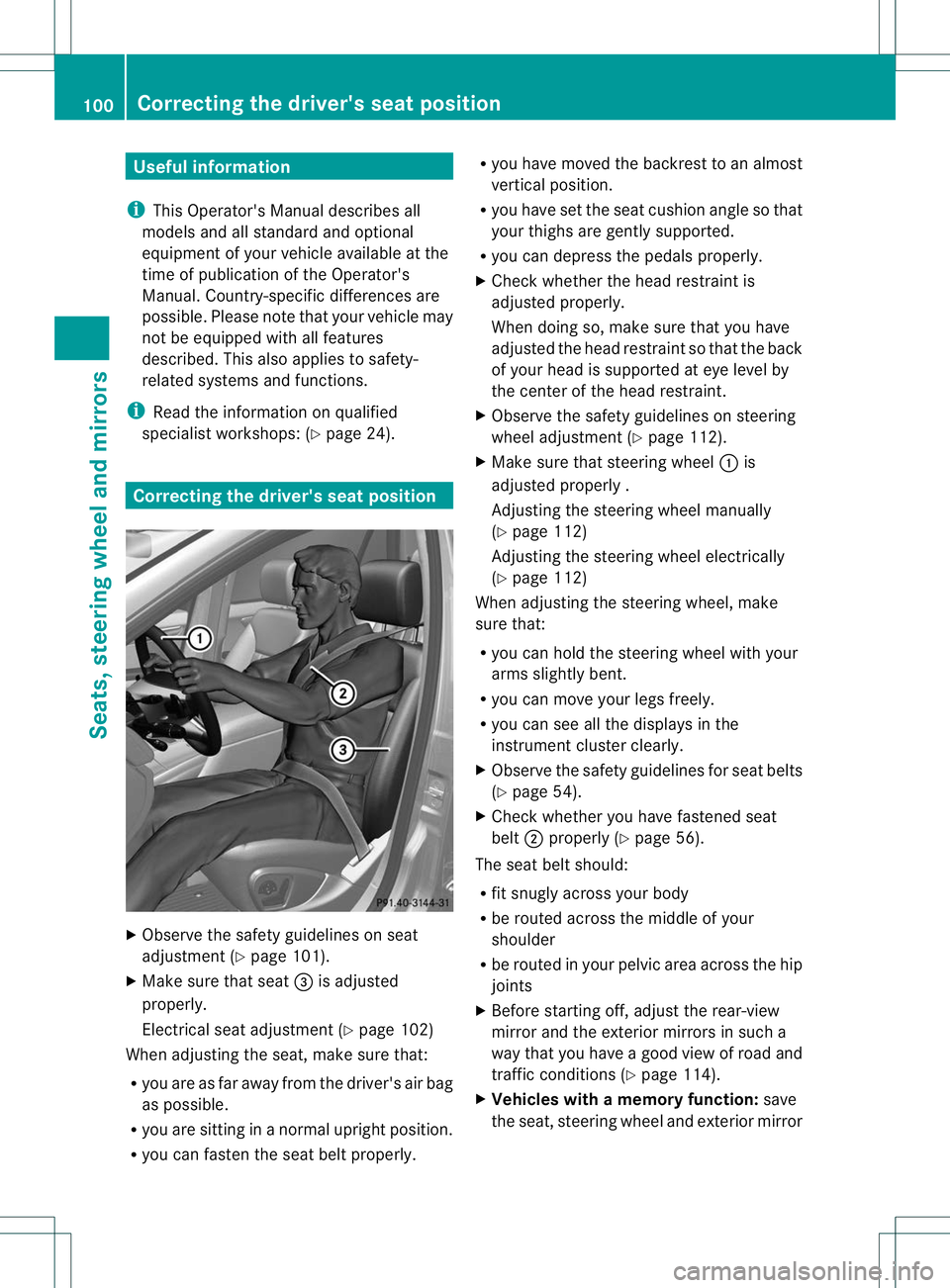
Useful information
i This Operator's Manual describes all
models and all standard and optional
equipment of your vehicle available at the
time of publication of the Operator's
Manual. Country-specific differences are
possible. Please note that your vehicle may
not be equipped with all features
described. This also applies to safety-
related systems and functions.
i Read the information on qualified
specialist workshops: (Y page 24).Correcting the driver's seat position
X
Observe the safety guidelines on seat
adjustment (Y page 101).
X Make sure that seat =is adjusted
properly.
Electrical seat adjustment (Y page 102)
When adjusting the seat, make sure that:
R you are as far away from the driver's air bag
as possible.
R you are sitting in a normal upright position.
R you can fastent he seat belt properly. R
you have moved the backrest to an almost
vertical position.
R you have set the seat cushion angle so that
your thighs are gently supported.
R you can depress the pedals properly.
X Check whether the head restraint is
adjusted properly.
When doing so, make sure that you have
adjusted the head restraint so that the back
of your head is supported at eye level by
the center of the head restraint.
X Observe the safety guidelines on steering
wheel adjustment (Y page 112).
X Make sure that steering wheel :is
adjusted properly .
Adjusting the steering wheel manually
(Y page 112)
Adjusting the steering wheel electrically
(Y page 112)
When adjusting the steering wheel, make
sure that:
R you can hold the steering wheel with your
arms slightly bent.
R you can move your legs freely.
R you can see all the displays in the
instrumentc luster clearly.
X Observe the safety guidelines for seat belts
(Y page 54).
X Check whether you have fastened seat
belt ;properly (Y page 56).
The seat belt should:
R fit snugly across your body
R be routed across the middle of your
shoulder
R be routed in your pelvic area across the hip
joints
X Before starting off, adjust the rear-view
mirror and the exterior mirrors in such a
way that you have a good view of road and
traffic conditions (Y page 114).
X Vehicles with a memory function: save
the seat, steering wheel and exterior mirror 100
Correcting the driver's seat positionSeats, steering wheel and mirrors
Page 104 of 364
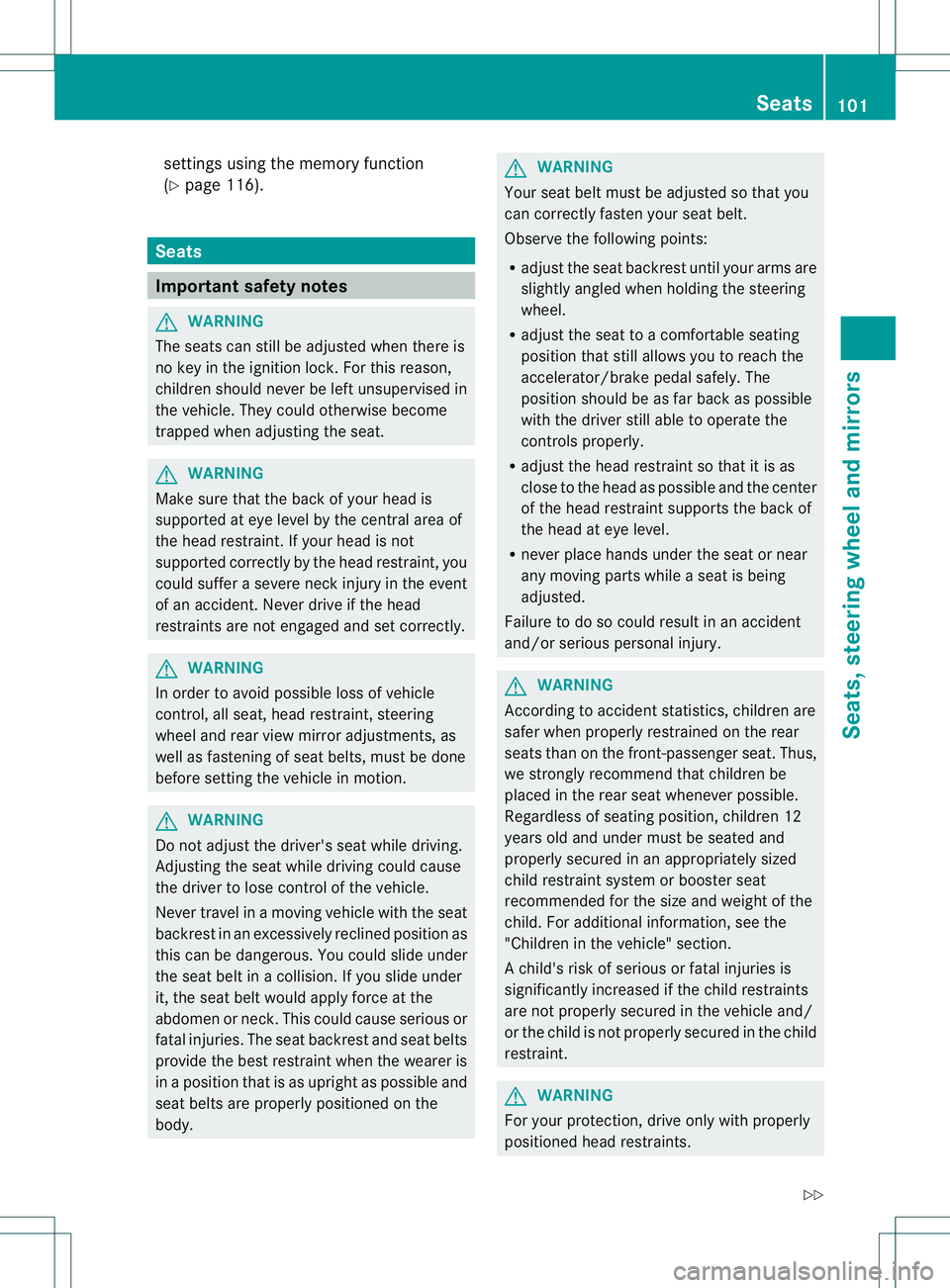
settings using the memory function
(Y
page 116). Seats
Important safety notes
G
WARNING
The seats can still be adjusted when there is
no key in the ignition lock. For this reason,
children should never be left unsupervised in
the vehicle. They could otherwise become
trapped when adjusting the seat. G
WARNING
Make sure that the back of your head is
supported at eye level by the central area of
the head restraint. If your head is not
supported correctly by the head restraint, you
could suffer a severe neck injury in the event
of an accident. Never drive if the head
restraints are not engaged and set correctly. G
WARNING
In order to avoid possible loss of vehicle
control, all seat, head restraint, steering
wheel and rear view mirror adjustments, as
well as fastening of seat belts, must be done
before setting the vehicle in motion. G
WARNING
Do not adjust the driver's seat while driving.
Adjusting the seat while driving could cause
the driver to lose control of the vehicle.
Never travel in a moving vehicle with the seat
backrest in an excessively reclined position as
this can be dangerous. You could slide under
the seat belt in a collision. If you slide under
it, the seat belt would apply force at the
abdomen or neck. This could cause serious or
fatal injuries. The seat backrest and seat belts
provide the best restraint when the wearer is
in a position that is as upright as possible and
seat belts are properly positioned on the
body. G
WARNING
Your seat belt must be adjusted so that you
can correctly fasten your seat belt.
Observe the following points:
R adjust the seat backrest until your arms are
slightly angled when holding the steering
wheel.
R adjust the seat to a comfortable seating
position that still allows you to reach the
accelerator/brake pedal safely.T he
position should be as far back as possible
with the driver still able to operate the
controls properly.
R adjust the head restraint so that it is as
close to the head as possible and the center
of the head restraint supports the back of
the head at eye level.
R never place hands under the seat or near
any moving parts while a seat is being
adjusted.
Failure to do so could result in an accident
and/or serious personal injury. G
WARNING
According to accident statistics, children are
safer when properly restrained on the rear
seats than on the front-passenger seat. Thus,
we strongly recommend that children be
placed in the rear seat whenever possible.
Regardless of seating position, children 12
years old and under must be seated and
properly secured in an appropriately sized
child restraint system or booster seat
recommended for the size and weight of the
child. For additional information, see the
"Children in the vehicle" section.
Ac hild's risk of serious or fatal injuries is
significantly increased if the child restraints
are not properly secured in the vehicle and/
or the child is not properly secured in the child
restraint. G
WARNING
For your protection, drive only with properly
positioned head restraints. Seats
101Seats, steering wheel and mirrors
Z
Page 105 of 364
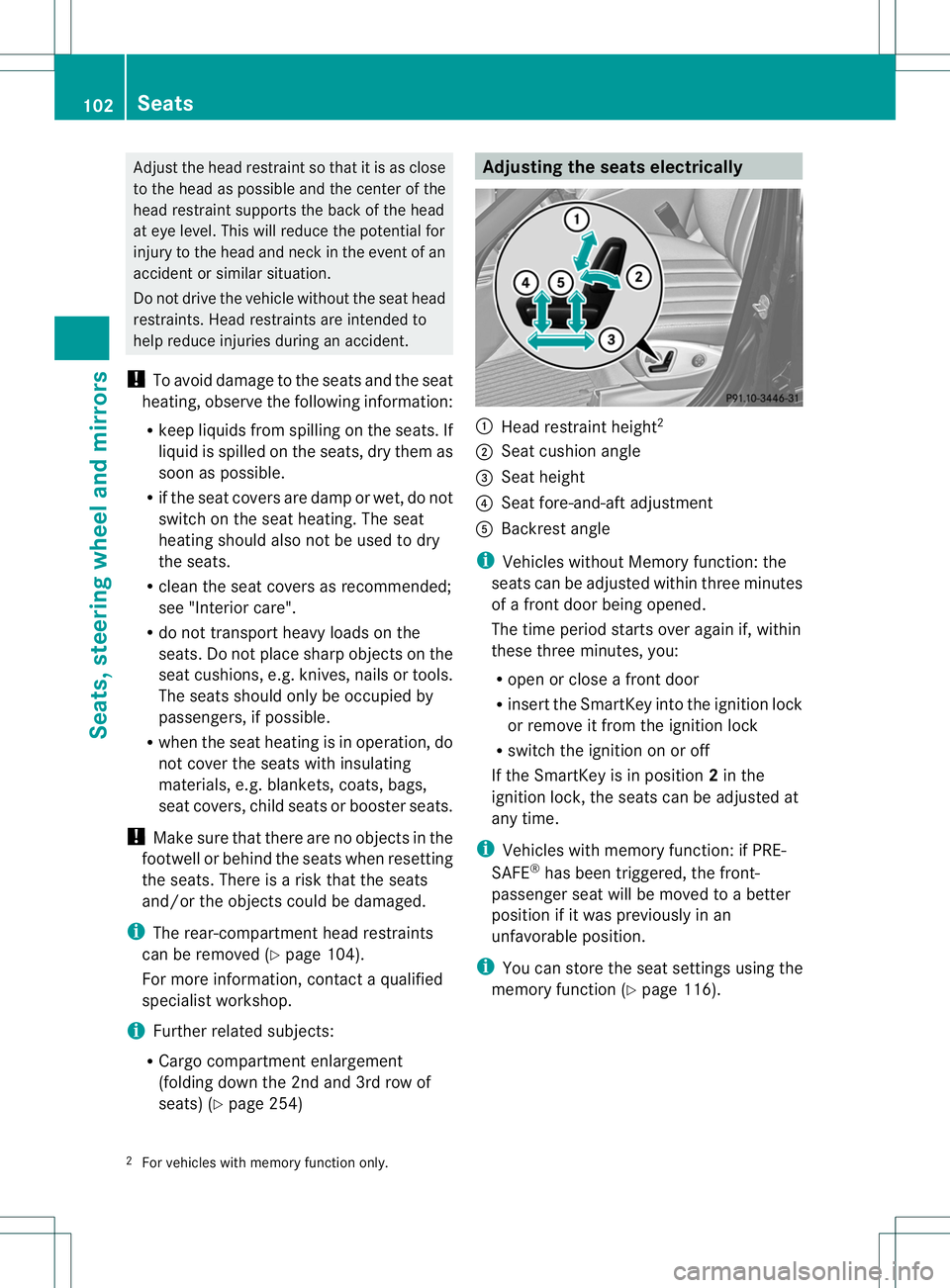
Adjust the head restraint so tha
titis as close
to the head as possible and the center of the
head restraint supports the back of the head
at eye level. This will reduce the potential for
injury to the head and neck in the event of an
accident or similar situation.
Do not drive the vehicle without the seat head
restraints. Head restraints are intended to
help reduce injuries during an accident.
! To avoid damage to the seats and the seat
heating, observe the following information:
R keep liquids from spilling on the seats. If
liquid is spilled on the seats, dry them as
soon as possible.
R if the seat covers are damp or wet, do not
switch on the seat heating. The seat
heating should also not be used to dry
the seats.
R clean the seat covers as recommended;
see "Interior care".
R do not transport heavy loads on the
seats. Do not place sharp objects on the
seat cushions, e.g. knives, nails or tools.
The seats should only be occupied by
passengers, if possible.
R when the seat heating is in operation, do
not cover the seats with insulating
materials, e.g. blankets, coats, bags,
seat covers, child seats or booster seats.
! Make sure that there are no objects in the
footwell or behind the seats when resetting
the seats. There is a risk that the seats
and/or the objects could be damaged.
i The rear-compartment head restraints
can be removed (Y page 104).
For more information, contact a qualified
specialist workshop.
i Further related subjects:
R Cargo compartment enlargement
(folding down the 2nd and 3rd row of
seats) (Y page 254) Adjusting the seats electrically
:
Head restraint height 2
; Seat cushion angle
= Seat height
? Seat fore-and-aft adjustment
A Backrest angle
i Vehicles without Memory function:t he
seats can be adjusted within three minutes
of a front door being opened.
The time period starts over again if, within
these three minutes, you:
R open or close a front door
R insert the SmartKey into the ignition lock
or remove it from the ignition lock
R switch the ignition on or off
If the SmartKey is in position 2in the
ignition lock, the seats can be adjusted at
any time.
i Vehicles with memory function: if PRE-
SAFE ®
has been triggered, the front-
passenger seat will be moved to a better
position if it was previously in an
unfavorable position.
i You can store the seat settings using the
memory function (Y page 116).
2 For vehicles with memory function only. 102
SeatsSeats, steering wheel and mirrors
Page 106 of 364
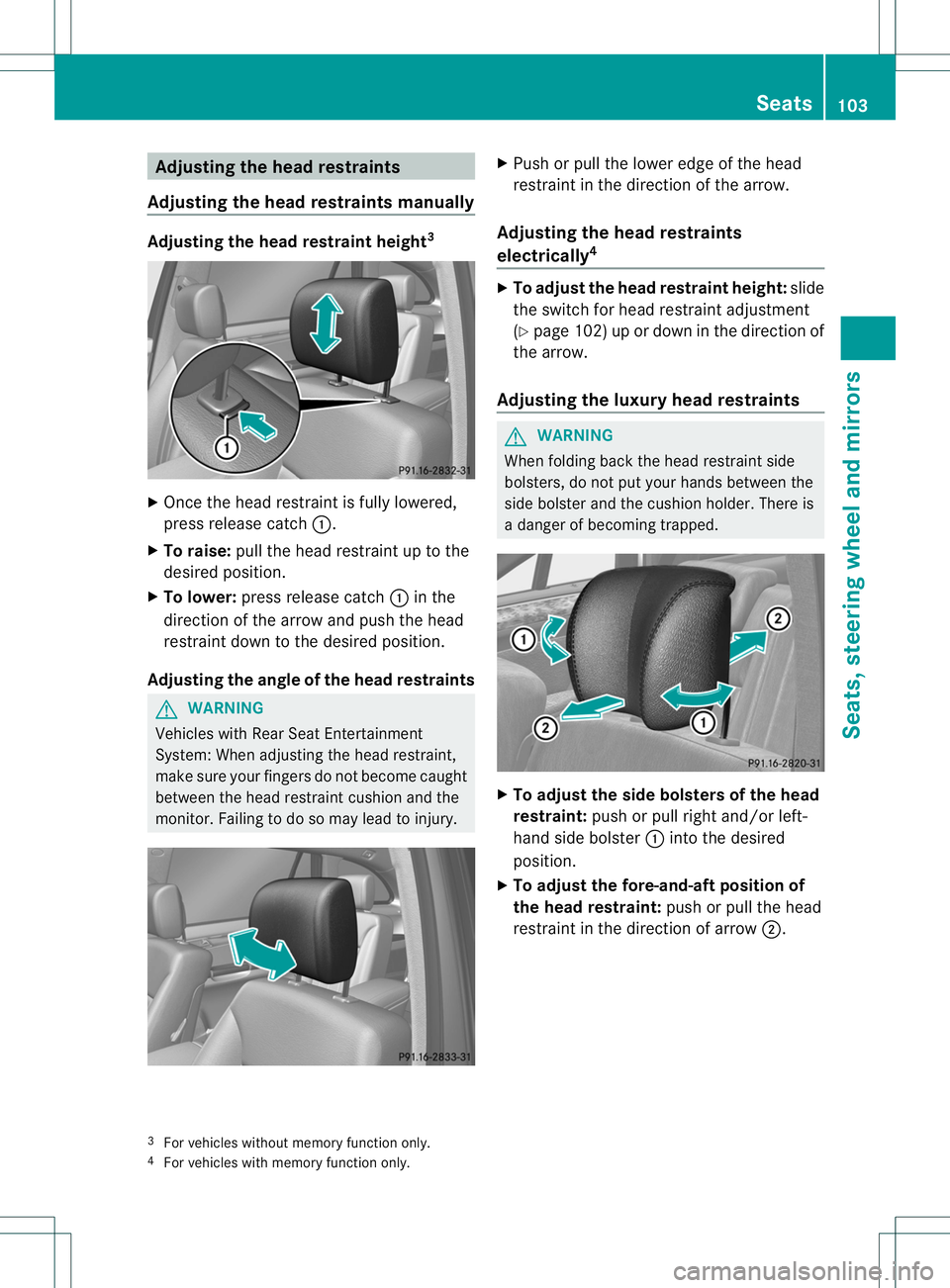
Adjusting the head restraints
Adjusting the head restraints manually Adjusting the head restraint height
3X
Once the head restrain tisfully lowered,
press release catch :.
X To raise: pull the head restraint up to the
desired position.
X To lower: press release catch :in the
direction of the arrow and push the head
restraint down to the desired position.
Adjusting th eangle of the head restraints G
WARNING
Vehicles with Rear Seat Entertainment
System :When adjusting the head restraint,
make sure your fingers do not become caught
between the head restraint cushion and the
monitor. Failing to do so may lead to injury. X
Push or pull the lower edge of the head
restraint in the direction of the arrow.
Adjusting the head restraints
electrically 4 X
To adjust the head restraint height: slide
the switch for head restraint adjustment
(Y page 102) up or down in the direction of
the arrow.
Adjusting the luxury head restraints G
WARNING
When folding back the head restraint side
bolsters, do not put your hands between the
side bolster and the cushion holder. There is
a danger of becoming trapped. X
To adjust the side bolsters of the head
restraint: push or pull right and/or left-
hand side bolster :into the desired
position.
X To adjust the fore-and-aft position of
the head restraint: push or pull the head
restraint in the direction of arrow ;.
3 For vehicles without memory function only.
4 For vehicles with memory function only. Seats
103Seats, steering wheel and mirrors Z
Page 107 of 364
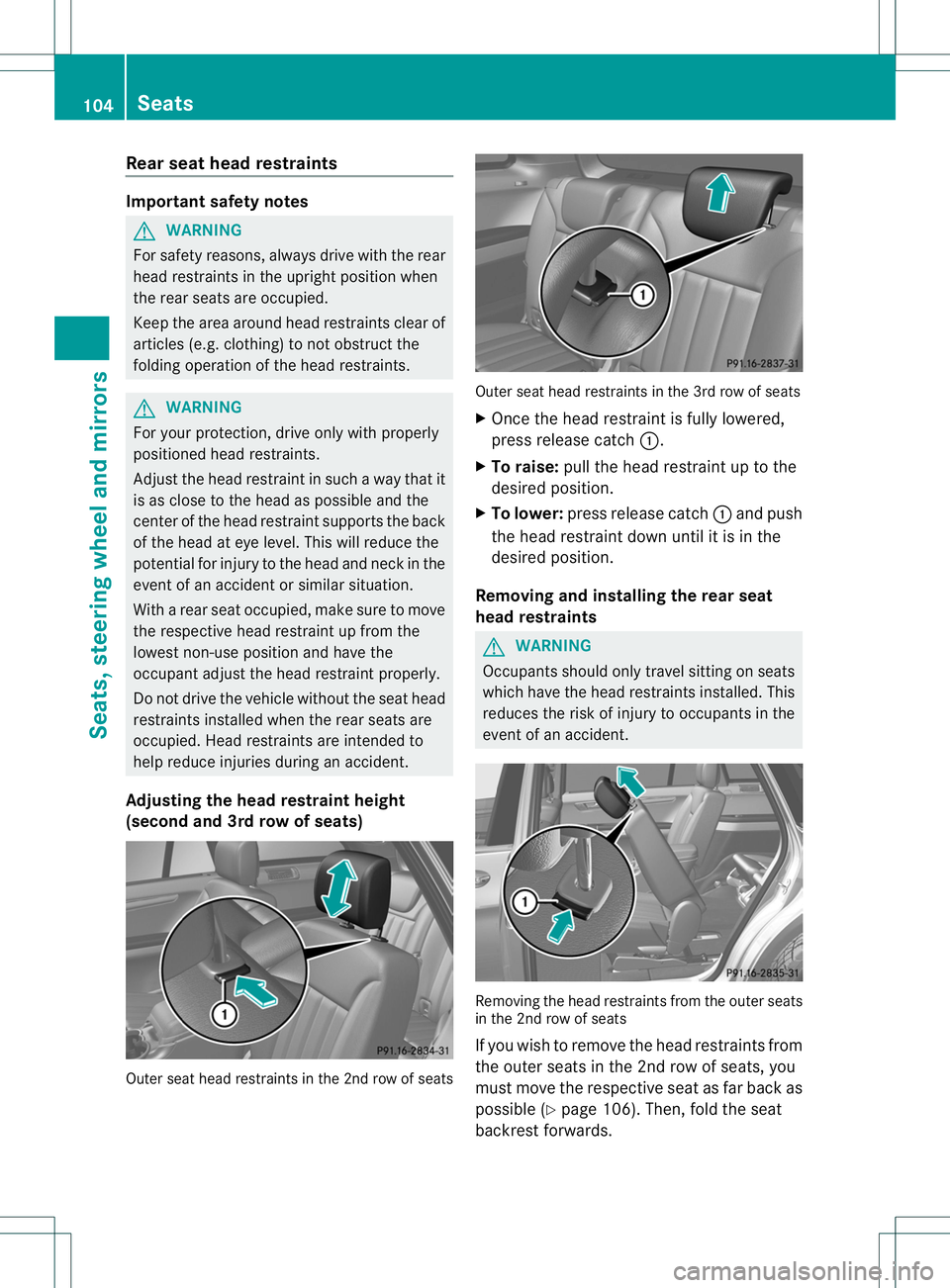
Rear seat head restraints
Important safety notes
G
WARNING
For safety reasons, always drive with the rear
head restraints in the upright position when
the rea rseats are occupied.
Keep the area around head restraints clear of
articles (e.g. clothing) to not obstruct the
folding operation of the head restraints. G
WARNING
For your protection, drive only with properly
positioned head restraints.
Adjust the head restraint in such a way that it
is as close to the head as possible and the
center of the head restraint supports the back
of the head at eye level. This will reduce the
potential for injury to the head and neck in the
event of an accident or similar situation.
With a rear seat occupied, make sure to move
the respective head restraint up from the
lowest non-use position and have the
occupant adjust the head restraint properly.
Do not drive the vehicle without the seat head
restraints installed when the rear seats are
occupied. Head restraints are intended to
help reduce injuries during an accident.
Adjusting the head restraint height
(second and 3rd row of seats) Outer seat head restraints in the 2nd row of seats Outer seat head restraints in the 3rd row of seats
X
Once the head restraint is fully lowered,
press release catch :.
X To raise: pull the head restraint up to the
desired position.
X To lower: press release catch :and push
the head restraint down until it is in the
desired position.
Removing and installing the rear seat
head restraints G
WARNING
Occupants should only travel sitting on seats
which have the head restraints installed. This
reduces the risk of injury to occupants in the
event of an accident. Removing the head restraints from the outer seats
in the 2nd row of seats
If you wish to remove the head restraints from
the outer seats in the 2nd row of seats, you
must move the respective seat as far back as
possible (Y
page 106). Then, fold the seat
backrest forwards. 104
SeatsSeats, steering wheel and mirrors
Page 108 of 364
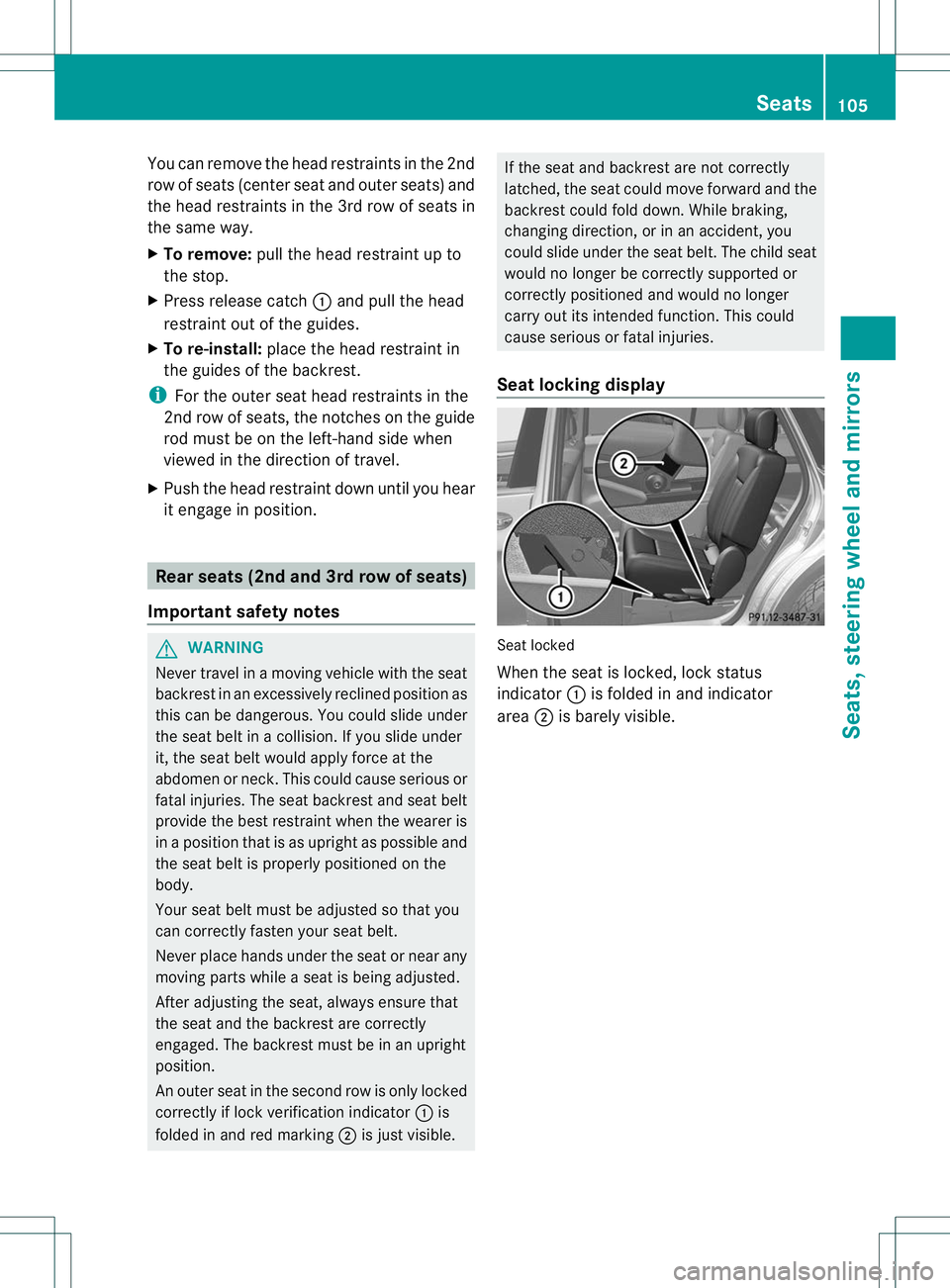
You can remove the head restraints in the 2nd
row of seats (center seat and outer seats) and
the head restraints in the 3rd row of seats in
the same way.
X
To remove: pull the head restraint up to
the stop.
X Press release catch :and pull the head
restraint out of the guides.
X To re-install: place the head restraint in
the guides of the backrest.
i For the outer seat head restraints in the
2nd row of seats, the notches on the guide
rod must be on the left-hand side when
viewed in the direction of travel.
X Push the head restraint down until you hear
it engage in position. Rear seats (2nd and 3rd row of seats)
Important safety notes G
WARNING
Never travel in a moving vehicle with the seat
backrest in an excessively reclined position as
this can be dangerous. You could slide under
the seat belt in a collision. If you slide under
it, the seat belt would apply force at the
abdomen or neck. This could cause serious or
fatal injuries. The seat backrest and seat belt
provide the best restraint when the wearer is
in a position that is as upright as possible and
the seat belt is properly positioned on the
body.
Your seat belt must be adjusted so that you
can correctly fasten your seat belt.
Never place hands under the seat or near any
moving parts while a seat is being adjusted.
After adjusting the seat, always ensure that
the seat and the backrest are correctly
engaged. The backrest must be in an upright
position.
An outer seat in the second row is only locked
correctly if lock verification indicator :is
folded in and red marking ;is just visible. If the seat and backrest are not correctly
latched, the seat could move forward and the
backrest could fold down. While braking,
changing direction, or in an accident, you
could slide under the seat belt. The child seat
would no longer be correctly supported or
correctly positioned and would no longer
carry out its intended function. This could
cause serious or fatal injuries.
Seat locking display Seat locked
When the seat is locked, lock status
indicator
:is folded in and indicator
area ;is barely visible. Seats
105Seats, steering wheel and mirrors Z
Page 109 of 364
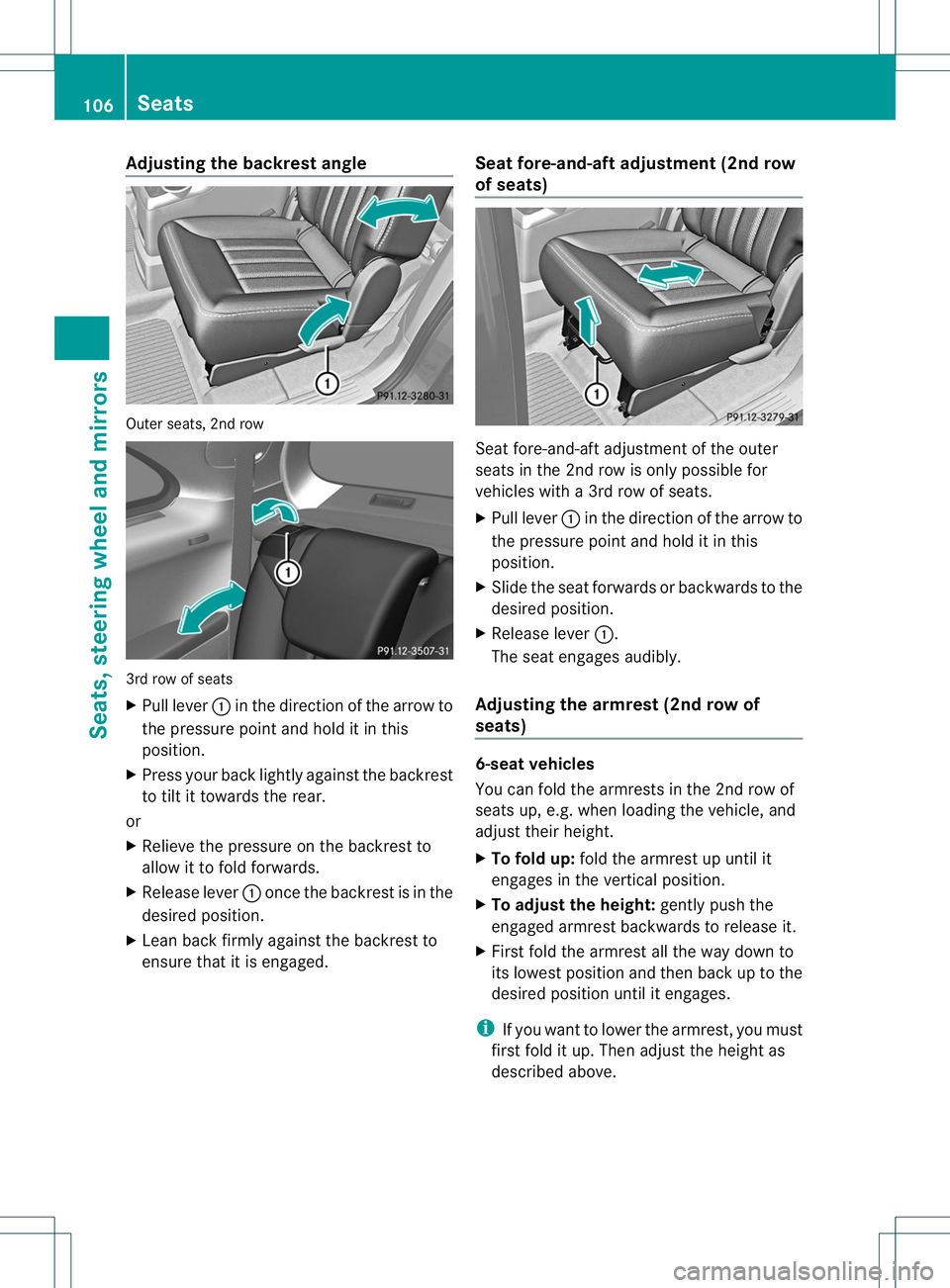
Adjusting the backrest angle
Outer seats, 2nd row
3rd row of seats
X
Pull lever :in the direction of the arrow to
the pressure poin tand hold it in this
position.
X Press your back lightly against the backrest
to tilt it towards the rear.
or
X Relieve the pressure on the backres tto
allow it to fold forwards.
X Release lever :once the backres tis in the
desired position.
X Lean back firmly against the backrest to
ensure that it is engaged. Seat fore-and-aft adjustment (2nd row
of seats) Seat fore-and-aft adjustment of the outer
seats in the 2nd row is only possible for
vehicles with a 3rd row of seats.
X
Pull lever :in the direction of the arrow to
the pressure point and hold it in this
position.
X Slide the seat forwards or backwards to the
desired position.
X Release lever :.
The seat engages audibly.
Adjusting the armrest (2nd row of
seats) 6-seat vehicles
You can fold the armrests in the 2nd row of
seats up, e.g. when loading the vehicle, and
adjust their height.
X
To fold up: fold the armrest up until it
engages in the vertical position.
X To adjust the height: gently push the
engaged armrest backwards to release it.
X First fold the armrest all the way down to
its lowest position and then back up to the
desired position until it engages.
i If you want to lower the armrest, you must
first fold it up. Then adjust the height as
described above. 106
SeatsSeats, steering wheel and mirrors
Page 110 of 364

7-seat vehicles
G
WARNING
The folded second-row middle seat is
intended to serve as an armrest only. Do not
fold the second-row middle seat and allow
occupants to use the folded second-row
middle seat as a footrest while driving .All
vehicle occupants must keep both feet on the
floor in front of their seat. Otherwise,
occupants could slide under the seat belt in a
collision. If occupants slide under it, the belt
would apply force at the abdomen or neck.
That could cause serious or even fatal injuries.
Do not fold the second-row middle seat and
allow occupants to use the folded second-row
middle seat as a table while driving. Objects
placed on the folded second-row middle seat
may move freely during braking, vehicle
maneuvers, or an accident and be thrown
around in the vehicle interior .Objects thrown
around in the vehicle interior may cause an
acciden tand/o rserious personal injury.
The backrest of the center seat in the 2nd row
can be used as an armrest.
X To put the backrest into the armrest
position: move the head restraint of the
center seat to the lowest position
(Y page 104). X
Pull release loop :in the direction of the
arrow and hold it in this position.
X Fold backrest ;forwards until it is resting
on seat cushion =in the armrest position. Armrest position
X
To move the backrest to its upright
position: pull release loop :in the
direction of the arrow and hold it in this
position.
X Fold backrest ;backwards until you hear
it engage.
Folding down the seats in the 2nd row
manually Important safety notes
G
WARNING
To help avoid personal injury, the second-row
seat backrests must be properly locked either
in the upright position or, when using the
expanded cargo volume, in the fully folded
position while the vehicle is in motion.
! Seven-seat vehicles:
Do not use the EASY-ENTRY/EXIT feature
on the left outer seat when the middle seat
in the second row of seats is in the armrest
position .You could otherwise damage the
seats.
! Vehicles with a Rear Seat Entertainment
System:
The screen of the Rear Seat Entertainment
System may be damaged if the head
restraint on the respective outer seat in the
second row of seats is extended
significantly when using the EASY-ENTRY/
EXIT feature. Seats
107Seats, steering wheel and mirrors Z